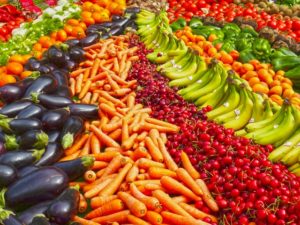 We have all heard the advice:
We have all heard the advice:
“Eat the Rainbow”
Of course, we are NOT talking about the rainbow found in a bag of Skittles or a box of “magically delicious” Lucky Charms! And, let’s face it, color is typically NOT a good thing when it comes to processed foods. Whenever you see Blue 2, Yellow 6 and Red 40 (among others), it’s best to just say “NO!”
When it comes to REAL food, color is a GREAT thing, and variety should be enjoyed frequently! But, maybe you have wondered, does color matter? Are red tomatoes better than green tomatoes? Is there a difference between red, black and green grapes? What about purple cauliflower vs. white?

First, let’s set the record straight.
All fruits and vegetables are good for you, no matter their color. Why? Because they are REAL food! And, they contain a unique package of vitamins, minerals and antioxidants that provide powerful health benefits.
There are differences in the nutrients, flavors and textures among different varieties of produce. That is why it is so important to enjoy a wide variety and recognize that the different varieties and colors are good for you for different reasons. If you are looking for a rule of thumb, generally, the deeper and richer the color, the better!
Here are some of the common questions we hear regarding different produce varieties:
Grapes…green, red or black?
 All grapes are sweet and juicy, and we love the many different varieties. Some green grapes tend to have a tart punch not commonly found in red or black grapes. Both varieties contain their own sets of antioxidants.
All grapes are sweet and juicy, and we love the many different varieties. Some green grapes tend to have a tart punch not commonly found in red or black grapes. Both varieties contain their own sets of antioxidants.
Red and black grapes contain higher levels of the powerful antioxidant resveratrol, which works as an anti-inflammatory and helps prevents cardiovascular disease, while green grapes contain catechins, which provide numerous benefits including promoting a healthy gut.
Bell peppers, how do you choose…green, red, orange, or yellow?

All varieties of peppers are loaded with nutrients such as Vitamin A and C, potassium and fiber, so they are incredibly beneficial to good health.
Red peppers pack the most nutrition because they have been on the vine the longest and contain the most beta-carotene and Vitamin C. Green peppers are harvested before they have a chance to turn yellow, orange and then red. This longer ripening process also tends to make red bell peppers taste a little sweeter. All bell peppers contain antioxidants, with varying levels in different colors…so, to get the most nutrition, make sure you are enjoying all the colors!
Cabbage…green or red?
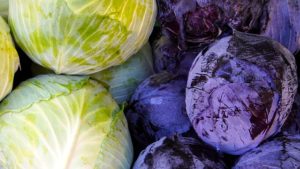 Red (or purple) cabbage typically has smaller and denser heads vs. the typical head of green cabbage. Red cabbage has more Vitamin A and C, and also contains powerful antioxidants (called anthocyanins), which give it its signature color and are extremely powerful in protecting against chronic disease and fighting inflammation. Green cabbage provides its own nutritional benefits, including higher levels of Vitamin K and folate. So, you can’t go wrong either way — try these ideas!
Red (or purple) cabbage typically has smaller and denser heads vs. the typical head of green cabbage. Red cabbage has more Vitamin A and C, and also contains powerful antioxidants (called anthocyanins), which give it its signature color and are extremely powerful in protecting against chronic disease and fighting inflammation. Green cabbage provides its own nutritional benefits, including higher levels of Vitamin K and folate. So, you can’t go wrong either way — try these ideas!
Zucchini or summer squash?
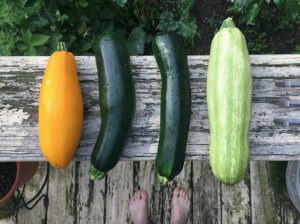 Summer squash, such as yellow or green (zucchini), are generally interchangeable. The main differences are color, shape and size.
Summer squash, such as yellow or green (zucchini), are generally interchangeable. The main differences are color, shape and size.
Zucchini are generally straight while yellow squash tend to be larger at the bottom and taper towards the top. Yellow squash also tends to have more seeds. You may want to consider purchasing smaller yellow squash, especially if using as a substitute for zucchini.
Beets…are there other colors than red?
 Yes, golden beets are also fantastic! All beets are very high in disease fighting phytonutrients, cancer-protective antioxidants, and contain compounds called gluthiones, which have been called “the mother of all antioxidants.”
Yes, golden beets are also fantastic! All beets are very high in disease fighting phytonutrients, cancer-protective antioxidants, and contain compounds called gluthiones, which have been called “the mother of all antioxidants.”
Many think golden, or yellow, beets taste slightly sweeter and less “earthy” than red beets and, although they don’t provide the vibrant red color, they are packed with an abundance of other antioxidants that orange and yellow foods provide. We encourage you to also be on the lookout for Chioggia beets, which are naturally striped like a candy cane and tend to be the sweetest variety.
Juicy summer tomatoes…red, purple, green, yellow or orange?
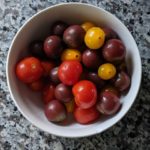 The beauty of tomatoes is the different varieties provide such unique flavors. Darker colored tomatoes tend to have more complex flavors while lighter colored varieties tend to be fruity and tangy. Red tomatoes are a great source of Vitamin C as well as antioxidants called carotenoids (especially lycopene and beta-carotene). While green tomatoes don’t provide the same level of carotenoids, they are still very nutritious, even providing slightly more calcium and vitamin C than red tomatoes — just remember frying them strips them of their nutritional punch. Instead, when they are in-season, try our Healthi-Fried Green Tomatoes.
The beauty of tomatoes is the different varieties provide such unique flavors. Darker colored tomatoes tend to have more complex flavors while lighter colored varieties tend to be fruity and tangy. Red tomatoes are a great source of Vitamin C as well as antioxidants called carotenoids (especially lycopene and beta-carotene). While green tomatoes don’t provide the same level of carotenoids, they are still very nutritious, even providing slightly more calcium and vitamin C than red tomatoes — just remember frying them strips them of their nutritional punch. Instead, when they are in-season, try our Healthi-Fried Green Tomatoes.
Cauliflower…what is the deal with purple and orange?
 Most cauliflower is white, because its coarse leaves keep the florets hidden from the sun, preventing the color-producing chlorophyll from forming. There are varieties other than white…including purple, green, and orange.
Most cauliflower is white, because its coarse leaves keep the florets hidden from the sun, preventing the color-producing chlorophyll from forming. There are varieties other than white…including purple, green, and orange.
Purple cauliflower (with a mild and slightly nutty taste) gets its color from the antioxidant, anthocyanin, which is also found in red cabbage and red wine. Others get their colors from breeding approaches…for example, the approach for orange cauliflower allows it to hold more beta carotene. No matter which color you enjoy, you will be eating one of the healthiest plants on the planet! As part of the cruciferous vegetable family (that includes cabbage, Brussels sprouts, broccoli and kale, among others), with its potent cancer fighting powers, make sure you are enjoying cruciferous veggies each and every day!
Potatoes…are there really differences?
 All potatoes contain healthy fiber! Sweet potatoes actually contain slightly more fiber than white potatoes, but both leave you feeling full, reducing the tendency to overindulge. Potatoes contain beneficial vitamins and nutrients, such as Vitamin A and C, with sweet potatoes being a Vitamin A powerhouse.
All potatoes contain healthy fiber! Sweet potatoes actually contain slightly more fiber than white potatoes, but both leave you feeling full, reducing the tendency to overindulge. Potatoes contain beneficial vitamins and nutrients, such as Vitamin A and C, with sweet potatoes being a Vitamin A powerhouse.
Purple potatoes are loaded with antioxidants (again, resulting from the anthocyanins found in red and purple produce). Many think the purple potatoes taste similar to white potatoes, while providing a creamier texture (making them great for mashing, roasting or sautéing). Don’t avoid potatoes because of the perception they are “high-carb” and high on the glycemic index. They are a wonderful part of a REAL food lifestyle.
Onions…aren’t they all the same?
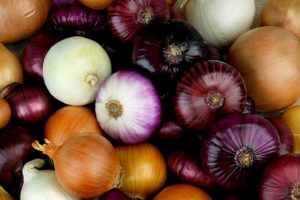 White and yellow onions have a milder flavor than red onions, while red onions are more likely to bring tears to your eyes (if you know what we mean). All varieties contain powerful antioxidant and anti-inflammatory phytonutrients that protect our cells and prevent disease.
White and yellow onions have a milder flavor than red onions, while red onions are more likely to bring tears to your eyes (if you know what we mean). All varieties contain powerful antioxidant and anti-inflammatory phytonutrients that protect our cells and prevent disease.
Like red cabbage and red beets, red onions have a high amount of that important flavonoid (you guessed it…anthocyanin), which gives red onions their vibrant color. The best thing about onions is they all provide health benefits and can easily be interchanged in cooking.
 As you can see, the more color provided by nature, the better…fruits and vegetables with deeper and richer colors do provide some nutritional advantages. Especially purple power! So, when you see purple potatoes available, GO FOR IT! And, keep purple cabbage on hand and add it to every salad — beneficial anthocyanins are something we need daily!
As you can see, the more color provided by nature, the better…fruits and vegetables with deeper and richer colors do provide some nutritional advantages. Especially purple power! So, when you see purple potatoes available, GO FOR IT! And, keep purple cabbage on hand and add it to every salad — beneficial anthocyanins are something we need daily!
And, the power of the rainbow extends beyond fruits and vegetables into whole grains too…black and red rice can be even more nutritious than brown.
Keep in mind, it’s not a competition…variety is key, and all varieties provide their own health benefits, flavors and textures.
Just keep it simple and eat REAL food!
 LEARN MORE ABOUT THE NAPKIN!
LEARN MORE ABOUT THE NAPKIN!
Thank you. Great information.
This was an article topic I didn’t know I needed until I read it!!! Thanks!